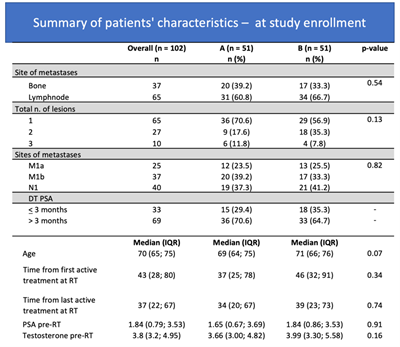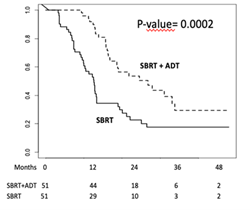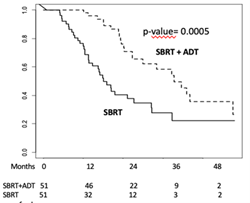ESTRO 2024 Congress report
Several prospective phase II trials have demonstrated a benefit for metastases-directed therapy (MDT) in selected patients with oligometastatic hormone-sensitive prostate cancer (HSPCa). While the STOMP and ORIOLE trials reported improved outcomes and androgen deprivation therapy (ADT)-free survival for MDT in comparison with observation, the recently published EXTEND trial demonstrated improved progression-free survival and eugonadal progression-free survival if intermittent ADT was combined with MDT.
The Italian phase II randomised RADIOSA trial (NCT03940235) compares two treatment approaches that involve analysis of the combination and sequencing of MDT and ADT: stereotactic body radiotherapy (SBRT) alone vs. SBRT combined with six months of ADT. Patients with biochemical recurrence after surgery or radiotherapy +- ADT and nodal (N1 and/or cM1a) and bone metastases (cM1b) with a maximum of three lesions were included. All patients were staged with molecular imaging that used positron emission tomography (PET) with choline or prostate-specific membrane antigen (PSMA). A total of 105 patients were included: 52 were randomised into the SBRT alone treatment (Arm A) and 53 into the SBRT + ADT treatment (Arm B). Among these, 51 patients in each arm were considered for analysis.
Table 1: Patient characteristics. PSA: prostate-specific antigen; RT: radiotherapy; IQR: interquartile range

After a median follow-up of 31 months, rates of biochemical progression-free survival (BPFS) and clinical progression-free survival (CPFS) were significantly improved when SBRT was combined with ADT (BPFS: hazard ratio (HR)=0,40; 95% confidence interval (CI) 0.24 - 0.66; CPFS: HR 0.39; 95% CI 0.23-0.68). Median BPFS was 12.6 months in Arm A and 26.8 months in Arm B. Median CPFS was 15.1 months in Arm A and 32.8 months in Arm B. Interestingly, patterns of relapse differed between the two treatment arms: 15 patients experienced polymetastatic relapse during follow-up in Arm A vs. only six patients in Arm B. Subgroup analysis confirmed the benefit of combined treatment for various subgroups.


Figure 1: Biochemical recurrence-free survival (left) and clinical progression-free survival (right)
In most patients who were treated with SBRT + ADT, testosterone levels recovered within one year. Additional quality-of-life analysis via questionnaires will clarify the impact of both treatments on patients. Analysis of the mutational signatures is ongoing, and this should shed light on risk stratification and optimal patient selection for SBRT.
In conclusion, the RADIOSA phase II trial showed significantly improved BPFS and CPFS when SBRT was combined with short-term ADT in patients with oligometastatic HSPCa and a maximum of three metastases defined by cholin- or PSMA-PET. The addition of ADT resulted in less polymetastatic disease progression.
References:
Proffered paper presented by Marvaso G: Short ADT + SBRT improves outcomes in oligorecurrent hormone-sensitive PCa: result of RADIOSA trial Radiother and Oncol. Supplement 1, May 2024
Dr. Simon Spohn Member of the ESTRO urology focus group

Department of Radiation Oncology University Medical Center Freiburg, Germany